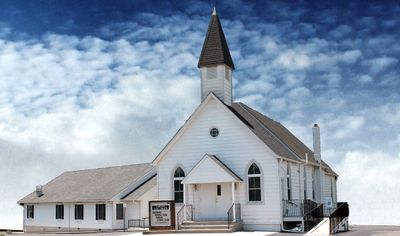Fairview's History
In tracing available records of the Fairview A.M.E. Church, it is evident that this “little church on the side of a hill” was built on the faith of a community that desired strongly to serve God with everything they possessed. According to early records, it was because of the “strong desire of the people of the communities of Forest Hill, Cooptown, and Jarrettsville for a place to worship, that a group met with the Superintendent of Schools in Harford County [to] ask permission to hold religious services in the school-house on Sundays. [And] as they worshiped, plans were made for the building of a church.”
Soon, the congregation of Fairview African Methodist Episcopal Church began to see their plans to build a church crystallize. In 1897, under the leadership of Reverend Murray, the building fund began to increase steadily, Mr. George Turner donated some property, and additional lots were purchased. As interest in the building program grew, it created a yearning for improvements in the worship service. Thus, camp meeting (held in tents), had its beginning.
The following pastors and the congregation continued to grow the church spiritually and physically. The church was ready for occupancy within 2 years, a bell was purchased for the church. In 1927 a parsonage was purchased and the church was wired for electric lights. A hall was dedicated in 1944 and named in honor of Deborah Bond. In 1946 Fairview purchased grounds to extend the cemetery, which was later dedicated as the Turner Memorial Cemetery.
Fairview has helped support local organizations in the community including SARC and the Harford Alliance for the Homeless. Each year our church gives presents to the children on behalf of their incarcerated parent by way of Angel Tree. We continue to work within the community.

The Fairview School
Fairview School, 1874 - 1945
The building located next to the fellowship hall was a school that educated black children in the Forest Hill area from about 1874 until 1945. The cost of the original school was paid with property taxes of “colored” residents and the Board of Education. The Commissioner’s minutes from September 1874 states Fairview’s trustees were: Thomas Moore, George Turner and David Presbury. The Colored Schools of Harford County: Separate, But Equal?, Part I, published by the Historical Society of Harford County, states the following about the colored schools:
In October 1876, the board ordered that colored schools would run, with regards to length and close of time, in the same manner as white schools. Teacher pay, colored and white, was set at $70 per ten-week term, except for high pay for teachers at Bel Air and Havre de Grace white schools. The board also ordered that colored schools could have scholars of more than 21 years of age. The pay was reduced to $65 per term in November 1877 because “the col’d fund is shown by the books to be in debt to the white fund.”
In 1888, old desks from the Hickory white school were handed down to the Fairview School and in 1901 modest repairs costing $14.50 were made. In the May 1906 to May 1907 school year, the Fairview trustees were Thomas Amos, Charles Bond and William Turner.
By 1908, the colored schools in Harford County were in deplorable condition. A new school was built by the mid-to-late 1920s and for a while both buildings served the community. The Fairview School closed in 1945.
Several of those that attended the Fairview School were interviewed in 2019 about their experiences in the school. Those interviewed were William “Shimmy” Greene, William Gover, Betty Presbury Mitchell, Mary Presbury and Edna Gover Ruff. The teachers at the time were Catherine Lee Gease and, later Fannie M. Jackson. The teachers taught grades 1 – 7.
Students walked to school; Betty Mitchell remembers walking several miles in the cold. By the time she got to school her hands were aching and the teacher, Fannie Jackson, worked on her hands to get them warm enough to do school work. All of the children walked to school and brought their lunch. Walking 2 – 3 miles to school was not unusual and children often walked in groups. There were no school buses for colored children. The practice of handing down books from the white schools continued until the school closed.
Shimmy Greene recalls coming to school early in the morning with his brother “Jigs” to light the pot-belly stove in the school. His cousin, Aggie, walked them to school each morning. A neighbor, Mr. Wysong, across the road allowed the children to get water. The day started at 9:00 AM with The Lord’s Prayer and then lessons began. A one-hour lunch/recess was at noon and favorite games were dodgeball and cowboys and Indians. Subjects included arithmetic, geography, long division, writing and history. Primary grade students were allowed to continue playing after lunch while the teacher continued lessons with the older students. The day ended at 4:00 PM. On Fridays the students helped oil the school floor. The teacher worked with the students to present Christmas plays.
Many of the members of Fairview attended the Fairview School. Those members include Catherine Greene Wade, Doris Greene, Mary Jamison Paschall, James Jamison, Sarah Holley Hall, Hallie Turner Jamison and William Maddox. It should be noted that William Gover, Shimmy Greene and Mary Presbury started school together and eventually graduated from the same class at Bel Air Colored High School.
The history of the Fairview School was obtained from Historical Society of Harford County publications Colored Schools of Harford County: Separate, But Equal?, Part I and Colored Schools of Harford County: Separate, But Equal?, Part II. Both were written by Doug Washburn.

This website uses cookies.
We use cookies to analyze website traffic and optimize your website experience. By accepting our use of cookies, your data will be aggregated with all other user data.